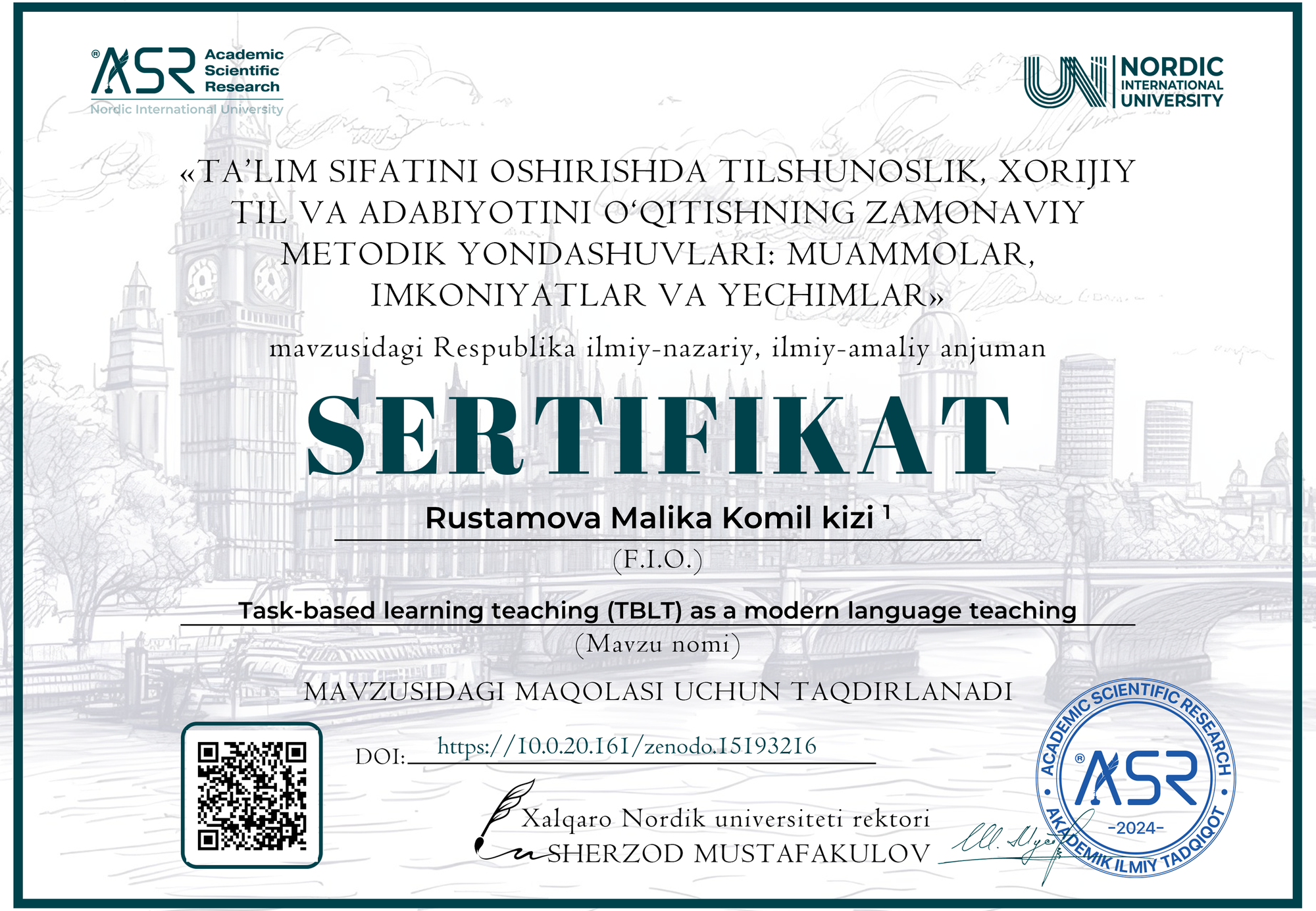Rustamova Malika Komil kizi 1

DOI: https://10.0.20.161/zenodo.15193216
Google scholar: https://scholar.google.com/scholar?hl=ru&as_sdt=0%2C5&q=%22TASK-BASED+LEARNING+TEACHING+%28TBLT%29+AS+A+MODERN+LANGUAGE+TEACHING%22&btnG=
Zenodo community: https://zenodo.org/records/15193216
Nordic_press journal: https://research.nordicuniversity.org/index.php/nordic/article/view/2311
MAQOLANI YUKLAB OLISH
SERTIFIKATNI YUKLAB OLISH
REVIEW:
The article by Rustamova Malika Komil kizi explores the concept of Task-Based Learning Teaching (TBLT) as a modern approach to language teaching. The author emphasizes TBLT’s focus on using meaningful tasks to foster language acquisition in a communicative context. This article provides an in-depth analysis of the method's key features, goals, benefits, and challenges, offering a comprehensive understanding of its role in contemporary language education.
The article defines TBLT as a student-centered approach where real-world tasks serve as the central component of the learning process. The emphasis on task completion shifts the focus from traditional grammar-based instruction to engaging students in activities that require the use of language as a tool for communication. According to the author, TBLT is closely linked to the communicative approach, where learners acquire the language needed to perform specific tasks, often involving problem-solving, role-playing, and other interactive exercises. These activities aim to improve fluency and communication skills rather than focusing on perfect grammatical accuracy, which is seen as a natural byproduct of effective communication.
Main Features of TBLT:The author highlights several key characteristics of TBLT:
Task-Centered Learning: The core of TBLT is the use of tasks that have clear goals, motivating students to apply their language skills in practical scenarios. Tasks such as problem-solving, role-playing, and projects encourage learners to use language actively.
Meaningful Communication: TBLT emphasizes real-life communication, where students interact, negotiate, and express their opinions, helping them develop functional communication skills.
Integration of Language Skills: The method integrates multiple language skills (speaking, listening, reading, writing), providing a holistic approach to language learning.
Student-Centered Learning: Teachers take on the role of facilitators, guiding students through tasks and helping them develop language skills through authentic communication.
Cultural Integration: The inclusion of cultural and historical elements, such as references to the Australian Kangaroo and the Uzbek Semurg (phoenix), helps students understand the cultural context of the language they are learning.
Authenticity: Tasks are designed to mirror real-world language use, which increases student motivation by demonstrating the relevance of what they are learning.
Assessment: Instead of traditional exams, TBLT uses performance-based assessments where students demonstrate their language skills by completing the tasks.
The article provides a balanced overview of the advantages and disadvantages of TBLT. On the positive side, the method encourages real-world relevance, enhances student engagement, and promotes critical thinking. It also helps build confidence and improves fluency. However, TBLT presents challenges, including the complexity of planning, classroom management, and balancing form and meaning in language use. Additionally, some students may struggle with insufficient vocabulary, and there is the potential for over-reliance on the first language during tasks.
Conclusion:In conclusion, the article effectively argues that TBLT is a highly effective and engaging approach to language teaching. By focusing on real-world tasks, this method prepares students to face challenges in practical communication situations. The student-centered nature of TBLT fosters collaboration, critical thinking, and fluency development. Although there are challenges associated with its implementation, the method’s benefits far outweigh the drawbacks, making it a valuable approach for modern language instruction. The author’s emphasis on task-based learning as a dynamic and meaningful educational tool is well-founded, and the article presents a persuasive case for its adoption in language teaching.
References:The article appropriately cites key works in the field of language teaching, such as Candlin and Murphy (1987), Allwright (1979), and Wills (1990), which provide the theoretical foundation for the TBLT approach. These references help to solidify the credibility and academic rigor of the discussion.
Overall Assessment:Rustamova's article provides a thorough and insightful exploration of Task-Based Learning Teaching (TBLT), showcasing its effectiveness in fostering real-world communication skills. The well-rounded discussion, which covers both the benefits and challenges, makes it an essential read for educators interested in modern, communicative approaches to language teaching.



